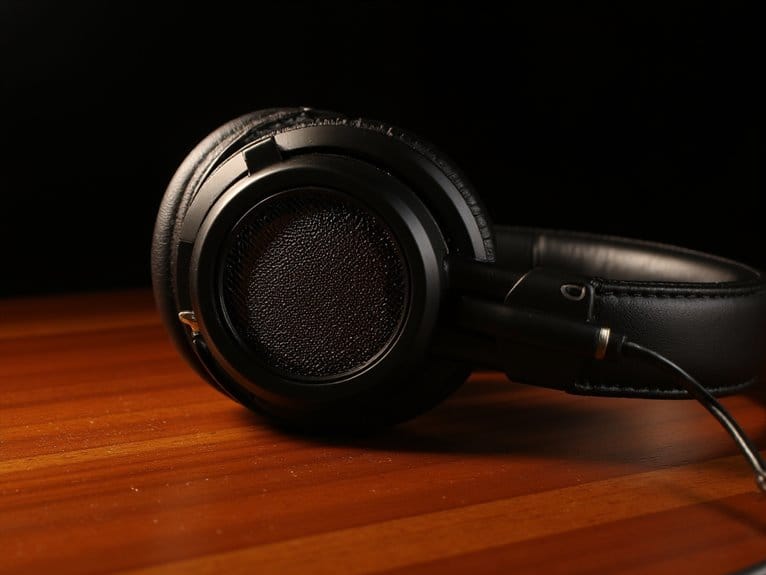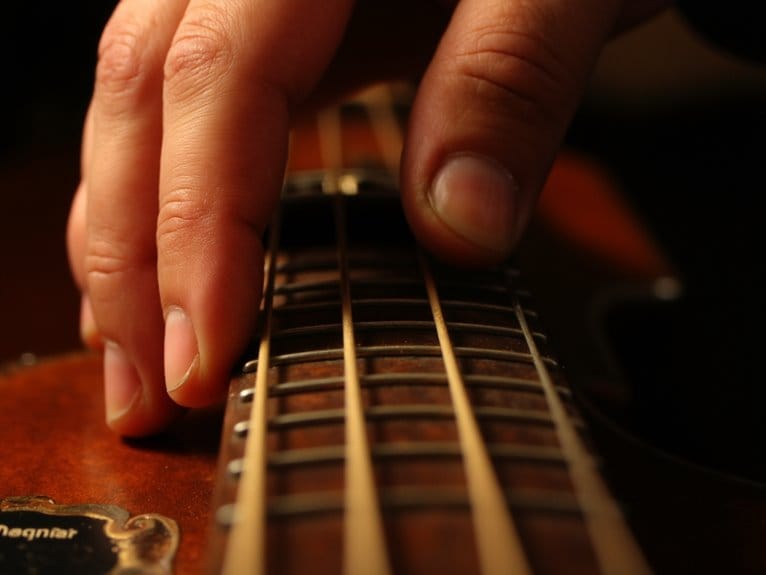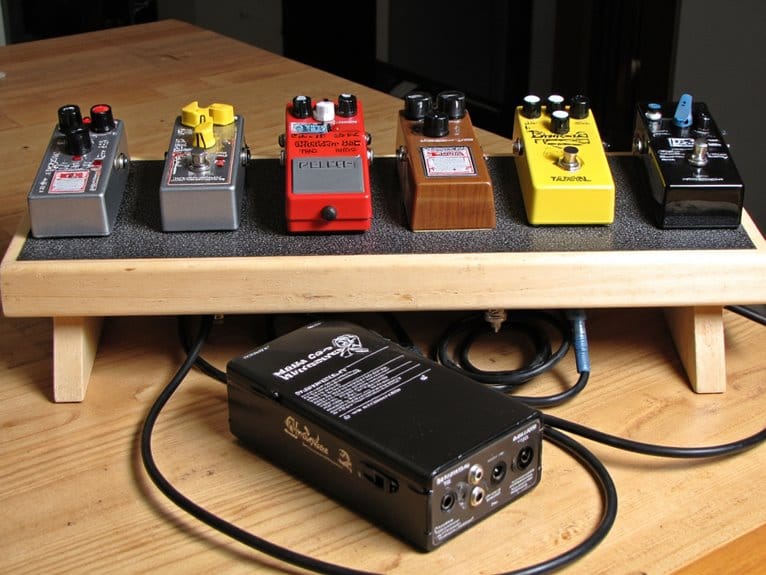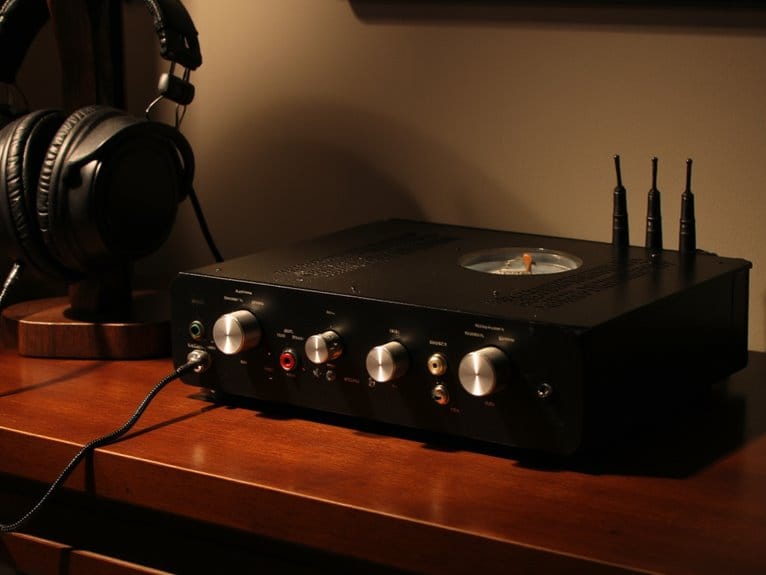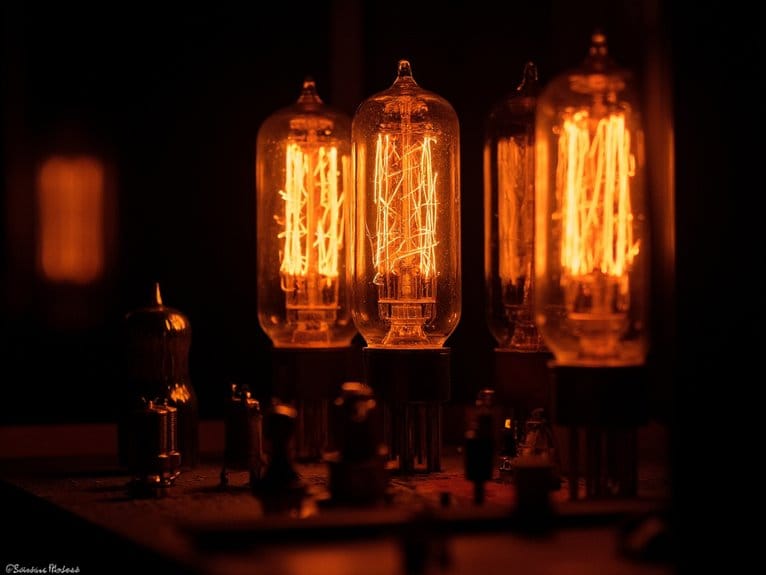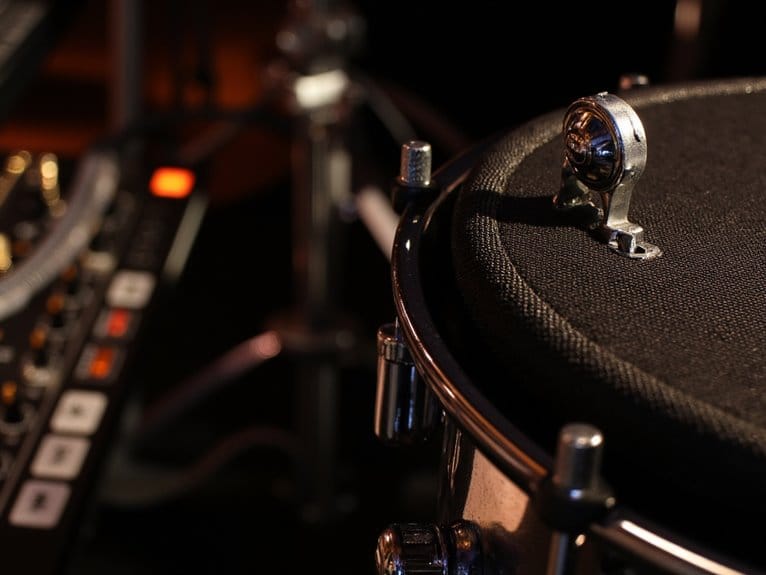Understanding Headphone Frequency Response and Why It Matters
Headphone frequency response measures how your headphones reproduce audio frequencies from 20 Hz to 20,000 Hz, fundamentally serving as your headphone’s sonic fingerprint that reveals which frequencies get emphasized or muted. You’ll find bass frequencies (20Hz-300Hz) add depth and power, midrange (300Hz-4kHz) guarantees vocal clarity, while treble (4kHz-20kHz) provides detail and sparkle. Understanding these characteristics helps you choose headphones that match your music preferences and discover the technical nuances that shape your listening experience.
We are supported by our audience. When you purchase through links on our site, we may earn an affiliate commission, at no extra cost for you. Learn more.
Notable Insights
- Frequency response measures how headphones reproduce audio frequencies from 20 Hz to 20,000 Hz, acting as the headphone’s unique audio fingerprint.
- Bass frequencies (20Hz-300Hz) provide depth and power, midrange (300Hz-4kHz) ensures vocal clarity, and treble (4kHz-20kHz) adds detail and sparkle.
- Frequency response graphs show peaks for emphasized frequencies and dips for reduced ones, with flat responses preferred for accurate sound reproduction.
- Different music genres benefit from specific frequency emphasis: bass-heavy for hip-hop, balanced for classical, and enhanced midrange/treble for gaming dialogue.
- Measurement challenges include environmental factors and design variations, making it important to consider multiple factors beyond just frequency response charts.
What Is Frequency Response and How Does It Work?
When I first started reviewing headphones professionally, I’ll admit I was intimidated by frequency response charts-those wavy line graphs that look like stock market reports gone wild-but understanding them becomes surprisingly straightforward once you grasp the fundamentals.
Frequency response basics fundamentally measure how well your headphones reproduce different audio frequencies, from deep bass at 20 Hz to sparkling highs at 20,000 Hz. Think of it as your headphone’s audio fingerprint, showing which frequencies get emphasized or muted. This human audible spectrum perfectly aligns with what our ears can naturally detect, making the 20 Hz to 20 kHz range the gold standard for headphone design.
The resulting curve reveals your headphone sound signature, whether it’s bass-heavy for hip-hop lovers or bright for detail seekers. These measurements use sound pressure level graphs that display energy output across the spectrum, giving you concrete data about what you’ll actually hear when you press play. Professional headphones like the Sony MDR7506 feature 40mm neodymium drivers that ensure flat frequency response across this entire range. Flat frequency response minimizes artificial enhancements, making headphones ideal for professional audio engineers who need accurate sound reproduction. A broader frequency range can enhance musical detail, but maintaining frequency balance across the spectrum is what truly determines whether your audio sounds natural or distorted.
The Impact of Frequency Response on Your Listening Experience
Now that you understand what frequency response measures, you’ll discover how dramatically these curves shape every moment of your listening experience, transforming the way vocals sit in the mix, how basslines punch through complex arrangements, and whether those delicate cymbal crashes sparkle or disappear entirely.
Your bass preferences fundamentally alter how genres like hip-hop and EDM deliver their intended impact, while tonal accuracy determines whether acoustic instruments maintain their natural timbre. Excessive treble emphasis creates listening fatigue during extended sessions, whereas muddy midrange response compromises vocal clarity and speech intelligibility.
| Frequency Range | Impact on Sound | Listener Effect |
|---|---|---|
| Bass (20Hz-300Hz) | Adds depth, power | Enhanced impact, potential muddiness |
| Midrange (300Hz-4kHz) | Vocal clarity, instrument presence | Speech intelligibility, natural balance |
| Treble (4kHz-20kHz) | Detail, sparkle, airiness | Crispness, possible fatigue |
Professional headphones that extend beyond the standard range to 40 kHz offer enhanced dynamic richness and superior detail retrieval for critical listening applications. Many in-ear headphones designed for bass enthusiasts feature larger dynamic drivers that can better reproduce the lower frequency ranges, allowing for more impactful delivery of those deep bass lines that define electronic and hip-hop genres.
How to Read and Interpret Frequency Response Graphs
How do you decode those seemingly cryptic squiggly lines that represent your headphones’ frequency response?
I’ll walk you through the essentials of graph interpretation, starting with the axes themselves. The x-axis displays frequency from 20 Hz to 20,000 Hz on a logarithmic scale, while the y-axis shows sound pressure level in decibels.
Peak identification becomes vital here-those upward spikes indicate louder frequencies that’ll color your music’s character. A bass peak below 200 Hz adds warmth, while treble peaks above 7 kHz create brightness.
Roll-offs represent gradual volume decreases at frequency extremes, and dips can reduce harshness but sacrifice detail. Understanding whether you’re viewing raw or compensated graphs matters greatly, since compensated versions aim for flatness to predict actual perceived sound.
Common Measurement Challenges and Limitations
While interpreting frequency response graphs provides valuable insights into headphone performance, the measurement process itself harbors significant complexities that can mislead even experienced audio enthusiasts.
You’ll encounter measurement variability stemming from differences in headphone designs, where over-ear models crossfade between 200-450 Hz while on-ear variants can reach 600-900 Hz, creating inconsistent baseline comparisons. Environmental factors, ear simulator variations, and headphone placement on test rigs compound these inconsistencies, particularly affecting bass and treble accuracy.
Target limitations present another hurdle, as popular references like the Harman Target Curve miss granular deviations and omit essential ear-specific effects, including the necessary 9-10 kHz dip from concha resonances. Heavy smoothing masks actual irregularities, making performance appear better than reality.
Choosing Headphones Based on Frequency Response Characteristics
Although frequency response measurements come with inherent limitations, they remain your most reliable tool for selecting headphones that’ll actually match your listening preferences and intended use cases.
Your sound signature preferences should guide your selection process, considering how different frequency responses affect your listening experience.
Here’s how to match headphones to your needs:
- Bass-heavy genres like EDM and hip-hop benefit from enhanced low-frequency reproduction below 20Hz for added depth and impact.
- Critical listening and classical music require balanced, flat frequency responses with minimal deviation (±3 dB) across the spectrum.
- Gaming applications favor enhanced midrange and treble clarity for dialogue comprehension and positional audio accuracy.
- Fitness activities prioritize consistent performance across movement with stable frequency reproduction.
For optimal bass reproduction in rap and hip-hop music, look for headphones with 40mm+ drivers that provide the necessary power to handle deep, punchy low-end frequencies without introducing muddiness into the mix.
Frequently Asked Questions
Can Frequency Response Be Adjusted or Modified After Purchasing Headphones?
Yes, you can modify your headphones’ sound using frequency manipulation techniques like graphic EQs and DSP. Digital equalization methods including convolution filters and calibration software let you customize audio output after purchase.
Do Wireless Headphones Have Different Frequency Response Than Wired Ones?
Yes, you’ll notice wireless headphones typically have a narrower frequency response than wired ones. Wireless technology requires audio compression, which can reduce sound quality, especially in deep bass and high frequencies.
How Does Headphone Impedance Affect Frequency Response Measurements and Performance?
Your headphone’s impedance interacts with your amplifier’s output impedance, creating voltage variations that alter frequency response. This affects measurement accuracy since you’re measuring the electrical interaction, not just the headphone’s acoustic properties alone.
What Frequency Response Differences Exist Between Open-Back and Closed-Back Headphones?
Open-back headphones give you wider soundstage perception with flatter midrange response, while closed-back models provide enhanced bass due to isolation characteristics but may exhibit frequency peaks from internal reflections affecting vocal clarity.
Do Expensive Headphones Always Have Better Frequency Response Than Budget Models?
No, expensive headphones don’t always have better frequency response than budget models. You’ll find no direct correlation between price and accuracy, though pricier options typically offer better build quality and more consistent sound signature with less variance.
On a final note
You’ve now got the foundation to decode those mysterious squiggly lines on frequency response graphs, and honestly, that’s more than most headphone buyers ever learn. While you shouldn’t obsess over perfect measurements-your ears are the final judge-understanding how bass bumps, treble peaks, and midrange dips affect your music will help you make smarter purchasing decisions and avoid overly hyped marketing claims.

